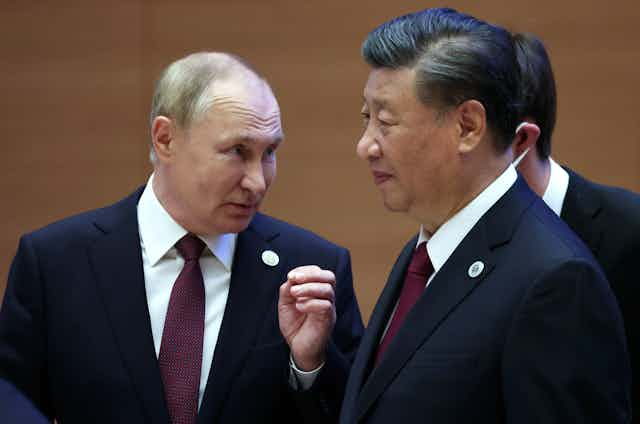Since the Russian invasion of Ukraine, China’s reaction in response to the Russian aggression has been fiercely debated in the western media. The majority of the discussions have focused on one particular term: “no-limits friendship” – a phrase believed to have been taken from a Sino-Russian joint statement issued a few months before the war.
But there is one problem with this phrase. While the Russian version of the statement indeed used the word “friendship”, the Chinese version used “friendliness”. Is this just an issue of translation, or did China deliberately avoid using the word “friendship”?
As a researcher who investigates problems of translations in international relations, I traced the usage of the word “friendship” in Chinese and Russian documents when describing their relationship. I discovered that the disconnect between the two nations’ view of the nature of their relationship first appeared in a treaty signed between the pre-communist government of China and the Soviet Union in 1945.
The treaty was named differently in its Chinese and Russian version. In the Russian edition, the treaty is “the Treaty of Friendship and Alliance”, whereas in the Chinese version, it is “the Treaty of Friendliness and Alliance”.
Such an asymmetrical way of labelling their partnership persisted in two more treaties signed after the founding of the current People’s Republic of China in 1949. The first is (in Russian) the “Treaty of Friendship, Alliance, and Mutual Assistance”, signed in 1950, and the other is the “Treaty of Good-Neighbourliness, Friendship and Cooperation”, signed in 2001. In both cases, the Chinese editions replaced the word “friendship” with “friendliness”, indicating that, despite the fall of USSR, the nature of Sino-Russian relations remained the same.
What is more, the 2019 Chinese statement regarding the development of the Sino-Russian comprehensive strategic partnership used the word “friendliness” repeatedly to describe the bilateral relationship between the two states. The word “friendship”, on the other hand, appeared only once when it was used specifically to refer to the “friendship” between Chinese and Russian people. This proves that it was not a translation mistake but rather a Chinese intention to differentiate “friendliness” from “friendship”.
Uneven relationship
Why is China so reluctant to use the “friendship” label? What does a Russian “friendship” mean to China? My research has indicated that Chinese resistance to the Russian “friendship” could be related to their experience with one particular organisation that had demonstrated through its conduct what a Soviet – and therefore by extension, Russian – “friendship” entailed for China. This organisation was the Soviet friendship fociety.
Formally established in 1927, the Soviet friendship societies were a network of communist organisations which sought to mobilise people outside of the socialist bloc who were sympathetic to Soviet ideology. With the rise of fascism in the 1930s and the consequent Soviet alignment with the United States, the societies were rebranded as facilitators of global cultural exchange and sought to influence a non-communist audience. The Sino-Soviet friendship societies grew out of these cultural exchanges.
In 1945, the Society for Chinese-Soviet Friendship was founded in Dalian, a city in northern China which was under Soviet control at the time. It immediately became popular among the locals. By 1949, there were more than 50 friendship societies across China.
But Chinese enthusiasm for these societies didn’t last long, as people came to realise what they represented. Chinese communists who had just led the country out of a devastating civil war wanted the Sino-Soviet relationship to be “mutually beneficial”. Through these friendship societies, they had hoped that the Soviets could teach China some know-how of socialist statecraft.
As Liu Shaoqi, then vice-president of the Chinese Communist Party, said in 1949, “The Soviet Union is China’s teacher. Chinese people should be pupils of the Soviet people.”

But Chinese officials were soon made aware of their own naiveté, as it became clear that the main purpose of these friendship societies was to propagate Soviet superiority and emphasise how grateful China should be for Soviet aid. The Shenyang society, for instance, often sponsored lectures with topics such as “How great is the Soviet Union?” and “Why does the Soviet Union help the Chinese people?”
By the end of the 1950s, it had become evident that instead of being “mutually beneficial”, there was a mutual misunderstanding of what the relationship between China and the Soviet Union was supposed to be. The Chinese believed that their hard-won communist victory should have earned the respect from and an equal footing with the Soviet Union. But for the Soviets, the newly-founded People’s Republic was just another satellite state within the vast Soviet system.
National borders and sovereignty did not matter in this socialist bloc. As far as the Soviets were concerned, the source of authority of this system had been – and would always come from – Moscow.
This suggests the Chinese reluctance to call the Sino-Russian partnership a “friendship” may be rooted in its previous interactions with the Soviet friendship societies. By deliberately not translating the word as “friendship”, China was showing its minimum resistance against a label that could make them once against susceptible to the Russian imperialist ambition.
In light of this, and given how much the Chinese statements about the war in Ukraine have stressed the importance of national sovereignty, it is clear that Chinese sympathy towards the Ukrainians comes from a slightly different place than that of the west. It comes not from a sense of morality or responsibility, but from the position of a fellow country who had to fight for equality and its own national identity within what was obviously an unequal relationship.

